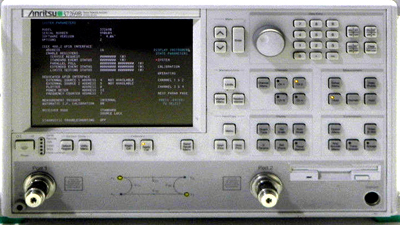
|
|
The Anritsu 37247B 20 GHz Vector Network Analyzer is a microprocessor controlled Analyzer. It is a single-instrument system that contains a built-in signal source, a test set, and an analyzer subsystem. The 37247B provides up to 1601 measurement data points, a built-in hard-disk drive for storing and recalling front panel setups and measurement and calibration data. It provides an on-screen display of total operational time and date of last system calibrations, and the number of power-off cycles since the last calibration. Frequency Range: 40 MHz to 20 GHz. Max Signal Into Port 2: +20 dBm @ 0.04 GHz, +3 dBm 2 to 20 GHz. Noise Floor: -70 dBm @ 0.04 GHz, -96 dBm @ 20 GHz, Max. -98 dBm @ 2 GHz. Receiver Dynamic Range (defined as the ratio of the maximum signal level at Port 2 for 0.1 dB compression to the noise floor at Port 2): 90 @ 0.04 GHz, 99 @ 20 GHz, Max. 101 @ 2 GHz. Port 1 Power: 0 dBm @ 0.04 GHz to 40 GHz. System Dynamic Range (defined as the ratio of the power incident on Port 2 in a through line connection to the noise floor at Port 2 (forward measurements only): 70 @ 0.04 GHz, 96 @ 20 GHz, Max. 98 @ 2 GHz. High Level Noise (typical): <0.03 dB and <0.4° peak-to-peak variation in a 1 kHz IF bandwidth up to 20 GHz, <0.08 dB and <0.5° peak-to-peak variation up to 40 GHz. Measurement Time vs. Span for 101 Data Points (typical): 40 MHz to 20 GHz, 500 ms. Number of Channels: Four independent measurement channels. Parameters: S11, S21, S22, S12, or user-defined combinations of a1, a2, b1, and b2. All measurements are made without the need to manually reverse the test device. Data Points: 1601 maximum. GPIB Interfaces: 2. Options. Opt 1, Rack Mounting. Opt. 1A, Rack Mounting. Opt 2, High Speed Time (Distance) Domain Measurement Capability. Opt 4, External SCSI-2 Hard Disk Drive Compatibility. Opt 7A/N/NF/S/K, Universal Test Port Configuration, Replaces Universal / K Connector (standard) with: 7A - Universal / GPC-7, 7N - Universal / N, male, 7NF - Universal / N, female, 7S - Universal / 3.5 mm, male. Opt 10A, High Stability Ovenized Time Base and 1 Hz Resolution.
|